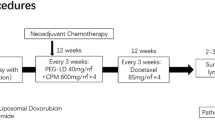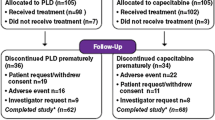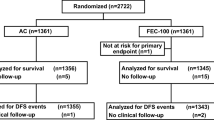Summary
Mitoxantrone (Novantrone®; dihydroxyanthracenedione) is an anthraquinone previously shown to be active in human breast cancer. It appears to have less toxicity than doxorubicin. Results of this phase II–III randomized cross-over trial to determine the relative efficacy and toxicity of mitoxantrone in comparison to doxorubicin, are presented. Patients with measurable, recurrent breast cancer with limited prior chemotherapy with or without radiotherapy for metastatic disease, and who had not been exposed to prior doxorubicin, were randomized to receive either mitoxantrone or doxorubicin every three weeks with crossover on progression. Response rates, duration of remission, time to treatment failure, and drug toxicity, including cardiac toxicity evaluated with serial radionuclide angiocardiography, were evaluated. Differences in the response rates for the two groups were not statistically significant. Neither time to treatment failure nor duration of response are significantly different (p>0.05). With respect to toxicity, mitoxantrone treated patients consistently exhibited a lower incidence and less severe drug toxicity as compared to their doxorubicin-treated counterparts. Cardiac toxicity was carefully monitored and thus four patients on doxorubicin have had drug related congestive heart failure, as compared to none on mitoxantrone.
In summary, mitoxantrone appears to be as active as doxorubicin in patients with stage IV breast cancer previously treated with chemotherapy; however, mitoxantrone causes significantly less nausea, vomiting, stomatitis and alopecia at doses which induce equal or greater myelosuppression than doxorubicin, and appears to be less cardiotoxic.
Similar content being viewed by others
References
American Cancer Society — Cancer Statistics — 1984: CA — a cancer journal for clinicians 34:7–23, 1984
Haskel CM: Management of metastatic breast cancer. Med Clin N Am 61(5):967–978, 1977
Hoogstraten B: Adriamycin (NSC-123127) in the treatment of advanced breast cancer: Studies by the Southwest Oncology Group. Cancer Chemother Rep (Part 3) 6:329–334, 1975
Von Hoff DD, Pollard E, Kuhn J, Murray E, Coltman CA Jr: Phase I clinical investigation of 1,4-dihydroxy-5, 8-bis [[2-[(2-hydroxyethyl) amino] ethyl] amino]-9, 10-anthra-cenedione dihydrochloride (NSC No. 301739), a new anthracenedione. Cancer Res 40: 1516–1518, 1980
United States Department of Health, Education, and Welfare: Breast cancer: Suggested protocol guidelines for combination chemotherapy trials and for combined modality trials. (DHEW) Publications (No. NIH 77–1192). Bethesda, Maryland, National Cancer Institute, 1977
Author information
Authors and Affiliations
Rights and permissions
About this article
Cite this article
Allegra, J.C., Woodcock, T., Woolf, S. et al. A randomized trial comparing mitoxantrone with doxorubicin in patients with stage IV breast cancer. Invest New Drugs 3, 153–161 (1985). https://doi.org/10.1007/BF00174163
Issue Date:
DOI: https://doi.org/10.1007/BF00174163




